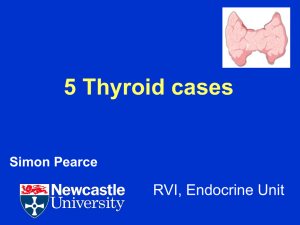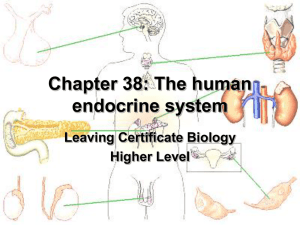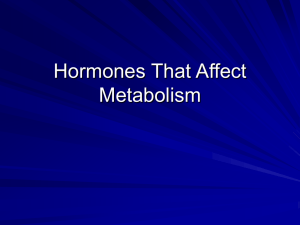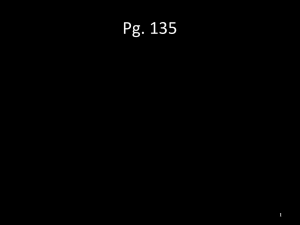NAME OF DRUG
advertisement
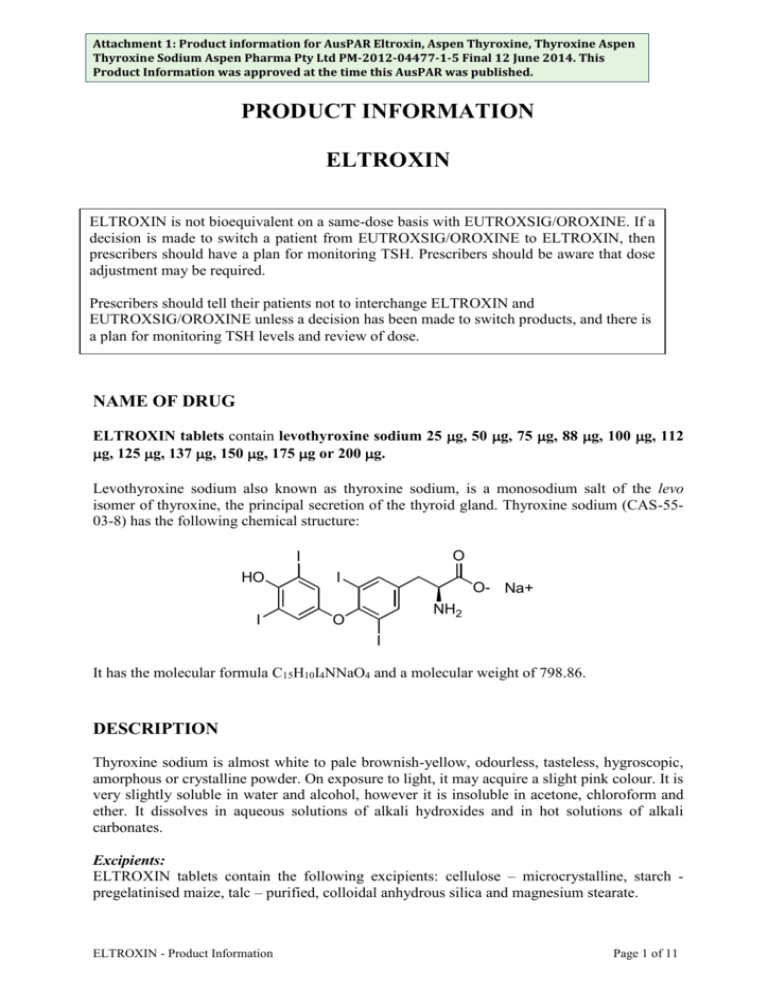
Attachment 1: Product information for AusPAR Eltroxin, Aspen Thyroxine, Thyroxine Aspen Thyroxine Sodium Aspen Pharma Pty Ltd PM-2012-04477-1-5 Final 12 June 2014. This Product Information was approved at the time this AusPAR was published. PRODUCT INFORMATION ELTROXIN ELTROXIN is not bioequivalent on a same-dose basis with EUTROXSIG/OROXINE. If a decision is made to switch a patient from EUTROXSIG/OROXINE to ELTROXIN, then prescribers should have a plan for monitoring TSH. Prescribers should be aware that dose adjustment may be required. Prescribers should tell their patients not to interchange ELTROXIN and EUTROXSIG/OROXINE unless a decision has been made to switch products, and there is a plan for monitoring TSH levels and review of dose. NAME OF DRUG ELTROXIN tablets contain levothyroxine sodium 25 g, 50 g, 75 g, 88 g, 100 g, 112 g, 125 g, 137 g, 150 g, 175 g or 200 g. Levothyroxine sodium also known as thyroxine sodium, is a monosodium salt of the levo isomer of thyroxine, the principal secretion of the thyroid gland. Thyroxine sodium (CAS-5503-8) has the following chemical structure: O I HO I I O O- Na+ NH2 I It has the molecular formula C15H10I4NNaO4 and a molecular weight of 798.86. DESCRIPTION Thyroxine sodium is almost white to pale brownish-yellow, odourless, tasteless, hygroscopic, amorphous or crystalline powder. On exposure to light, it may acquire a slight pink colour. It is very slightly soluble in water and alcohol, however it is insoluble in acetone, chloroform and ether. It dissolves in aqueous solutions of alkali hydroxides and in hot solutions of alkali carbonates. Excipients: ELTROXIN tablets contain the following excipients: cellulose – microcrystalline, starch pregelatinised maize, talc – purified, colloidal anhydrous silica and magnesium stearate. ELTROXIN - Product Information Page 1 of 11 Attachment 1: Product information for AusPAR Eltroxin, Aspen Thyroxine, Thyroxine Aspen Thyroxine Sodium Aspen Pharma Pty Ltd PM-2012-04477-1-5 Final 12 June 2014. This Product Information was approved at the time this AusPAR was published. PHARMACOLOGY Actions: ELTROXIN is used as thyroid replacement therapy for the treatment of hypothyroidism. The principal pharmacological effect of thyroid hormones is to increase the metabolic rate of body tissues. Thyroid hormones are also involved in the regulation of cell growth and differentiation. Thyroxine is the major component of normal secretions of the thyroid gland; therefore it is the essential determinant of normal thyroid function. Pharmacokinetics: Absorption Thyroxine sodium is variably but adequately absorbed from the gastrointestinal tract following oral administration. Approximately 50 to 75% of thyroxine sodium is absorbed. Studies in humans indicate that thyroxine sodium is absorbed from the jejunum and ileum, and in the duodenum. Fasting will only increase the extent of absorption, whereas malabsorption will only cause a decrease in absorption. Following the initiation of therapy, thyroxine sodium has a slow onset of action as the peak therapeutic effect occurs between 3 to 4 weeks. It also has a long duration of action occurring between 1 to 3 weeks, even following the discontinuance of the drug. Distribution Thyroxine sodium apparently undergoes enterohepatic circulation. Once inside the circulation, thyroxine is extensively protein bound, principally to thyroxine-binding globulin (TBG) and also to a lesser extent to thyroxine-binding pre-albumin (TBPA) or to albumin. Thyroxine is distributed into most body tissues and fluids with the highest concentration occurring in the liver and kidneys. A minimal amount of thyroxine is distributed into breast milk. Elimination Thyroxine sodium has a plasma half-life in euthyrodism of about 6 to 7 days. In hypothyroidism, the half life is prolonged between 9 to 10 days. However, the half-life is reduced between 3 to 4 days in hyperthyroidism. Thyroxine is primarily metabolised in the liver and in the kidney to tri-idothyronine. Approximately 40% of thyroxine sodium is metabolised to the inactive reverse tri-idothyronine, which both undergo further deiodination to inactive metabolites. About 85% of the thyroxine sodium metabolised daily is deiodinated. Thyroxine is reported to undergo enterohepatic recycling and is excreted in faeces. Comparison to reference registered products (EUTROXSIG/OROXINE) A single dose, 2-period, 2-treatment, crossover study compared the T4 levels of 31 healthy, fasting adults after a supra-therapeutic dose of Eltroxin (600 µg) versus the same dose of Oroxine (600 µg). For uncorrected total T4, the results for the ratio of Eltroxin/Oroxine were AUC0-t=89.1% (90% CI: 84.7%, 93.7%); Cmax=86.2%(82.1%, 90.6%). This suggests that Eltroxin may be less bioavailable than Oroxine. ELTROXIN - Product Information Page 2 of 11 Attachment 1: Product information for AusPAR Eltroxin, Aspen Thyroxine, Thyroxine Aspen Thyroxine Sodium Aspen Pharma Pty Ltd PM-2012-04477-1-5 Final 12 June 2014. This Product Information was approved at the time this AusPAR was published. INDICATIONS ELTROXIN is indicated for the management of demonstrated thyroid hormone deficiency. ELTROXIN is also used to suppress thyrotropin (TSH) for the management of TSHresponsive tumours of the thyroid. CONTRAINDICATIONS Known hypersensitivity to thyroxine, which has been described rarely, is a contraindication. ELTROXIN is contraindicated in the following conditions: -Untreated hyperthyroidism -Uncorrected primary or secondary adrenal insufficiency -Thyrotoxicosis -Acute myocardial infarction uncomplicated by hypothyroidism PRECAUTIONS Do not interchange ELTROXIN and EUTROXSIG/OROXINE. If a decision is made to switch from EUTROXSIG/OROXINE to ELTROXINE, then prescribers should be aware that dose adjustment may be required; TSH should be monitored. Initiation of therapy: In the elderly or patients with ischaemic heart disease, ELTROXIN should not be initiated at more than 50 µg/day, and dose then be gradually increased. (see DOSAGE & ADMINISTRATION). Presence of cardiac disorder: Extreme caution is required in patients with a cardiovascular disorder. In the event of cardiovascular effects, the dosage of ELTROXIN should be lowered. Even smaller initial dosage (eg 12.5 to 25 µg/day) should be used with increments of not more than 25 µg/day at not less than two week intervals. If this routine is not tolerated because of angina, increments should be further reduced with prolongation of the intervals between changes. The use of a ß blocker may help to control angina. Cortisone deficiency: Corticosteroid replacement therapy must precede initiation of ELTROXIN therapy to avoid Addisonian crisis in such conditions as hypopituitarism and adrenal insufficiency. Effects on bone mineral density: ELTROXIN - Product Information Page 3 of 11 Attachment 1: Product information for AusPAR Eltroxin, Aspen Thyroxine, Thyroxine Aspen Thyroxine Sodium Aspen Pharma Pty Ltd PM-2012-04477-1-5 Final 12 June 2014. This Product Information was approved at the time this AusPAR was published. In women, long-term levothyroxine sodium therapy has been associated with increased bone resorption, thereby decreasing bone mineral density, especially in post-menopausal women on greater than replacement doses or in women who are receiving suppressive doses of levothyroxine sodium. The increased bone resorption may be associated with increased serum levels and urinary excretion of calcium and phosphorus, elevations in bone alkaline phosphate and suppressed serum parathyroid hormone levels. Therefore, it is recommended that patients receiving levothyroxine sodium be given the minimum dose necessary to achieve and desired clinical and biochemical response. Diabetes: Caution is also required when ELTROXIN is given to hypothyroid patients with diabetes mellitus or diabetes insipidus, as it may cause the required dosage of insulin and oral antidiabetic agents to be increased. Careful monitoring of diabetic control is recommended, especially when ELTROXIN therapy is initiated, changed or discontinued. Adjustments in the dosage of these agents should only be made accordingly if necessary. Renal Disorder: There is no evidence that ELTROXIN dosage should be modified in the presence of renal failure. However, thyroid function tests may be influenced and need careful interpretation. Liver disorders: In spite of the major involvement of the liver in ELTROXIN metabolism, there is no evidence that dosage should be modified in the presence of cirrhosis. However, thyroid function tests may be influenced and need careful interpretation. Hyperthyroidism: Lower doses of ELTROXIN may be required in patients with a history of hyperthyroidism, as such patients may have residual autonomous thyroid function. Thyrotoxicosis: Patients who have thyrotoxicosis who are being treated with anti-thyroid medication, may have increased sensitivity to ELTROXIN. Long-standing Hypothyroidism and Myxodema: Caution is also required for patients with long-standing hypothyroidism or myxodema, as they are more sensitive to thyroid hormones. Carcinogenicity, Mutagenicity and Impairment to Fertility: Animal studies to determine the carcinogenic or mutagenic potential of thyroid agents have not been established. However, there is epidemiological evidence against the use of thyroid supplements enhancing the risk of breast cancer. There is no information available on the possible effects of thyroxine on human fertility. Use in Pregnancy (Category A): If overt hypothyroidism is diagnosed during pregnancy, thyroid function test results should be normalised as rapidly as possible. In newly-diagnosed hypothyroidism in pregnancy, thyroxine dosage should be titrated rapidly, for example 1.5–2.0 µg/kg/day may be required for initial replacement. If hypothyroidism has been diagnosed before pregnancy, thyroxine therapy should be optimised before conception and monitored during pregnancy by measurement of serum TSH and thyroxine levels. The thyroxine dose commonly needs incremental ELTROXIN - Product Information Page 4 of 11 Attachment 1: Product information for AusPAR Eltroxin, Aspen Thyroxine, Thyroxine Aspen Thyroxine Sodium Aspen Pharma Pty Ltd PM-2012-04477-1-5 Final 12 June 2014. This Product Information was approved at the time this AusPAR was published. adjustments by 4–6 weeks of gestation and may require a 25-40% increase in dosage. It is recommended that those levels should be re-evaluated every 3 to 4 weeks during the first and second trimesters, with thyroxine dosage changes as appropriate. The requirement is likely to decrease post-partum. Monitoring of TSH concentrations can give guidance. TBG increases during pregnancy and therefore total T4 and T3 may appear to be elevated. Measurement of free T4 and T3 may be more appropriate. There is contradictory evidence concerning the passage of T4 and T3 across the placenta but it is unlikely that the fetus is at risk. Clinical experience does not indicate any adverse effects on the fetus when thyroxine is administered during pregnancy. Australian categorisation definition of: Category A: Drugs which have been taken by a large number of pregnant women and women of childbearing age without any proven increase in the frequency of malformations or other direct or indirect harmful effects on the fetus having been observed. Use in Lactation: Women who are breast feeding should continue to take ELTROXIN. In euthyroid women, breast milk contains negligible amounts of thyroid hormone. The Use in Children: Studies performed have not yet demonstrated paediatric-specific problems that would limit the usefulness of thyroid hormones in children. However, neonates should be carefully observed for evidence of altered thyroid functions. This caution is required, as the infant pituitary gland is relatively insensitive to negative feedback effects of thyroid hormones. The parents of children who are receiving the thyroid agent need to be aware that partial loss of hair may occur during the first few months of therapy. However this effect is usually transient and subsequent regrowth usually occurs. Use in the Elderly: These patients may be more sensitive to the effects of thyroid hormones. ELTROXIN should be gradually introduced in the elderly and in those with long-standing hypothyroidism, so that any sudden increases in metabolic demands may be avoided. Individualisation of dosage is recommended and caution is required, as occult cardiac disease may be present. DRUG INTERACTIONS Oral anticoagulants, coumarin or indandione derivative eg. warfarin: Depending on the thyroid status of the patient, concurrent use of oral anticoagulants with ELTROXIN will increase the therapeutic effects of oral anticoagulants. Therefore, an increase in the dosage of ELTROXIN may necessitate a decrease in the oral anticoagulant dosage. Adjustment of oral anticoagulant dosage is recommended on the basis of prothrombin time. Patients should be observed closely for adverse effects. SSRIs eg. sertraline: The effects of ELTROXIN in hypothyroid patients may be decreased by concomitant use of sertraline, therefore resulting in an increase in ELTROXIN requirements. ELTROXIN - Product Information Page 5 of 11 Attachment 1: Product information for AusPAR Eltroxin, Aspen Thyroxine, Thyroxine Aspen Thyroxine Sodium Aspen Pharma Pty Ltd PM-2012-04477-1-5 Final 12 June 2014. This Product Information was approved at the time this AusPAR was published. Insulin and Antidiabetic agents eg. sulfonylurea: ELTROXIN may increase the required dosage of insulin and other oral antidiabetic drugs. Therefore, careful monitoring of diabetic control is recommended. Beta-adrenergic blocking agents eg. propranolol: These agents may decrease the peripheral conversion of thyroxine to triiodothyronine. Ion-exchange resins eg. cholestyramine, sodium polystyrene sulphonate or colestipol: Due to concurrent use of ion-exchange resins with ELTROXIN, the effects of ELTROXIN may be reduced due to the resin binding to ELTROXIN in the gastrointestinal tract, causing a delay or impairment in ELTROXIN absorption. An interval of 4 to 5 hours between the administration of the two medications is recommended. Corticosteroids eg. prednisolone and dexamethasone: The clearance of corticosteroids may be increased in hyperthyroid patients, and decreased in hypothyroid patients, solely due to the administration, changes in dosage and discontinuation of ELTROXIN. Therefore, corticosteroid dosage may need to be adjusted. Oestrogen: In patients with a non-functioning thyroid gland, oestrogen may increase the serum thyroxinebinding globulin, therefore generating an increase in ELTROXIN requirements. Antiepileptics eg. phenytoin, carbamazepine and barbiturates: These agents may increase the hepatic degradation of ELTROXIN, therefore resulting in an increase in ELTROXIN requirements. Ritonavir: Ritonavir may interact with ELTROXIN, therefore resulting in an increase in ELTROXIN requirements. Antimalarials: The combined use of chloroquine and proguanil may increase the hepatic degradation of ELTROXIN, therefore resulting in an increase in ELTROXIN requirements. Antibacterials eg. rifampicin and ciprofloxacin: Rifampicin may increase the hepatic degradation of ELTROXIN, therefore resulting in an increase in ELTROXIN requirements. Oral ciprofloxacin may decrease the absorption of ELTROXIN. An interval of 6 hours between the administration of the two medications is recommended. Androgens: Androgens may decrease the concentration of the serum thyroxine-binding globulin, therefore generating a decrease in ELTROXIN requirements. Ketamine: Cautious administration of ketamine is recommended in patients on ELTROXIN therapy, as marked hypertension and tachycardia may occur. ELTROXIN - Product Information Page 6 of 11 Attachment 1: Product information for AusPAR Eltroxin, Aspen Thyroxine, Thyroxine Aspen Thyroxine Sodium Aspen Pharma Pty Ltd PM-2012-04477-1-5 Final 12 June 2014. This Product Information was approved at the time this AusPAR was published. Lithium: Due to the direct action of lithium on the thyroid gland, inhibition of thyroid hormones may result, leading to clinical hypothydroidism. Tricyclic antidepressants: Due to concurrent use with ELTROXIN, an increase in the sensitivity to catecholamines may occur, therefore increasing the therapeutic and toxic effects of both drugs. Sympathomimetics: Due to concurrent use with ELTROXIN, there may be an increase in the effects of both drugs, which may lead to a risk of coronary insufficiency. Digoxin: Thyroxine may reduce the clinical effects of digoxin. Amiodarone: Amiodarone can occasionally decrease the peripheral conversion of thyroxine to triiodothyronine. However, any dose adjustment should be based on TSH levels. In addition: Thyroxine can enhance the clinical effects of pentobarbitone and dihydrotachysterol. Therefore, the adjustment of dosage may be necessary. The clinical effect of thyroxine can be reduced by soya flour, sucralfate, aluminium hydroxide, magnesium hydroxide, calcium carbonate, and ferrous sulphate - which interfere with absorption from the gastrointestinal tract. If these substances are taken, then their ingestion should be separated by several hours from the ingestion of thyroxine. Thyroid function tests can be modified, without changes in clinical effect of thyroxine, by some NSAIDs, salicylates, diazepam, heparin and fenclofenac. ADVERSE REACTIONS Individual patients vary in response to both the maintenance dose of ELTROXIN and to the size and frequency of dose increments. Too large an increment or too high a replacement dose can lead to manifestations of thyrotoxicosis which include: Cardiovascular: Chest pain, tachycardia, cardiac arrhythmias, palpitations, angina, myocardial ischaemia, myocardial infarction, heart failure, death. Nervous system: Irritability, anxiety, nervousness, excitability, restlessness, tremors, headache, poor concentration, emotional lability, sleep disturbance, insomnia, mania, psychosis, psychotic depression, seizures, petit mal status epilepticus, pseudotumour cerebri (especially in children). Gastrointestinal system: ELTROXIN - Product Information Page 7 of 11 Attachment 1: Product information for AusPAR Eltroxin, Aspen Thyroxine, Thyroxine Aspen Thyroxine Sodium Aspen Pharma Pty Ltd PM-2012-04477-1-5 Final 12 June 2014. This Product Information was approved at the time this AusPAR was published. Diarrhoea, vomiting, malabsorption. Skin: Warmth, erythema, telangectiasia, hyperhydrosis, alopecia, hyperpigmentation. Respiratory system: Increased minute ventilation, tachypnoea, and shortness of breath. Neuromuscular system: Myopathy, lid lag, muscle weakness and cramps. Reproductive system: Amenorrhoea, menstrual irregularities, decreased libido, gynaecomastia (in male). Metabolic: Fever, glucose intolerance, weight loss, premature craniosynostosis (in children) TRH suppression, heat intolerance, sweating, flushing. ELTROXIN - Product Information Page 8 of 11 Attachment 1: Product information for AusPAR Eltroxin, Aspen Thyroxine, Thyroxine Aspen Thyroxine Sodium Aspen Pharma Pty Ltd PM-2012-04477-1-5 Final 12 June 2014. This Product Information was approved at the time this AusPAR was published. DOSAGE AND ADMINISTRATION Thyroxine is best taken as a single daily dose first thing in the morning. It should be taken with water and on an empty stomach, and at least 30 minutes and preferably 60 minutes before the intake of any food or other medications. Thyroxine is best ingested in the fasting state, as food will impair absorption. The dose should be individualised on the basis of clinical response and biochemical tests. Regular monitoring of TSH and thyroxine is recommended when starting therapy or changing the dose. Adults Initial dose Commence with thyroxine 50 to 100 micrograms daily. Increase the daily dose by 25 to 50 micrograms according to response at not less than 4-weekly intervals, up to 100 to 200 micrograms daily. In the patients aged 60 years and over and in those with ischaemic heart disease, thyroxine therapy should normally be initiated with low doses (25 or 50 μg/day). Wherever possible, whole tablets should be taken (eg if the dose required is 150 g then 1 x 100 g tablet and 1 x 50 g tablet should be taken, rather than 1 ½ x 100 g tablets). When there is no contraindication to full thyroxine replacement, a TSH level of about 1 mU/L with a serum thyroxine level in the high-normal range, usually indicates optimal therapy. Maintenance doses Adults: 100 to 200 µg per day. Children: Congenital and acquired hypothyroidism Age Thyroxine dose/kg/day 0-6 months 8 µg approximately 6-12 months 6 µg approximately 1-5 years 5 µg approximately 6-12 years 4 µg approximately 12 years and over 2 µg approximately Note: The lowest dose compatible with clinical euthyroidism and satisfactory laboratory values should be used. ELTROXIN - Product Information Page 9 of 11 Attachment 1: Product information for AusPAR Eltroxin, Aspen Thyroxine, Thyroxine Aspen Thyroxine Sodium Aspen Pharma Pty Ltd PM-2012-04477-1-5 Final 12 June 2014. This Product Information was approved at the time this AusPAR was published. OVERDOSAGE Within three to six days after ingestion any or all of the symptoms and signs listed under Precautions and Adverse Reactions may become evident. They may progress to “thyroid storm”, with hyperpyrexia, convulsions, heart failure, coma and subsequent death. Treatment of overdose: Early treatment has included gastric lavage, induced emesis and ingestion of activated charcoal. Oxygen may need to be administered and ventilation may need to be maintained. Treatment is usually symptomatic and supportive. Measures to control fever, hypoglycemia or fluid loss should be initiated as necessary. Of various adrenergic ß blockers, propranolol has been used commonly to control cardiac arrhythmia and other manifestations. Reserpine, guanethidine, and digoxin have also been used. Exchange transfusion has been recommended for progressive deterioration. When overdose does occur, there must be an extended follow-up period as symptoms may be delayed for several days due to the gradual peripheral conversion of thyroxine to triiodothyronine. PRESENTATION (Oral Tablets): 25 microgram, round, white coloured, flat, bevelled tablets debossed with ‘25’ on one side and bisected on the other side, in bottles of 200 tablets. 50 microgram, round, white coloured, flat, bevelled tablets debossed with ‘50’ on one side and ‘L01’ on the other side, in bottles of 200 tablets. 75 microgram, round, white coloured, flat, bevelled tablets debossed with ‘75’ on one side and ‘L02’ on the other side, in bottles of 200 tablets. 88 microgram, round, white coloured, flat, bevelled tablets debossed with ‘88’ on one side and ‘L07’ on the other side, in bottles of 200 tablets. 100 microgram, round, white coloured, flat, bevelled tablets debossed with ‘100’ on one side and ‘L10’ on the other side, in bottles of 200 tablets. 112 microgram, round, white coloured, flat, bevelled tablets debossed with ‘112’ on one side and ‘L11’ on the other side, in bottles of 200 tablets. 125 microgram, round, white coloured, flat, bevelled tablets debossed with ‘125’ on one side and ‘L12’ on the other side, in bottles of 200 tablets. 137 microgram, round, white coloured, flat, bevelled tablets debossed with ‘137’ on one side and ‘L15’ on the other side, in bottles of 200 tablets. 150 microgram, round, white coloured, flat, bevelled tablets debossed with ‘150’ on one side and ‘L17’ on the other side, in bottles of 200 tablets. 175 microgram, round, white coloured, flat, bevelled tablets debossed with ‘175’ on one side and ‘L20’ on the other side, in bottles of 200 tablets. 200 microgram, round, white coloured, flat, bevelled tablets debossed with “200” on one side and ‘L21’ on the other side, in bottles of 200 tablets. * All tablet strengths may not be available in Australia. ELTROXIN - Product Information Page 10 of 11 Attachment 1: Product information for AusPAR Eltroxin, Aspen Thyroxine, Thyroxine Aspen Thyroxine Sodium Aspen Pharma Pty Ltd PM-2012-04477-1-5 Final 12 June 2014. This Product Information was approved at the time this AusPAR was published. STORAGE Store below 25°C. Store in the original container and protect from light. Keep the container tightly closed. POISONS SCHEDULE S4 (Prescription Only Medicine) NAME AND ADDRESS OF SPONSOR Aspen Pharma Pty Ltd 34-36 Chandos Street, St. Leonards NSW 2065 Australia TGA approval date: 9 May 2014 ELTROXIN - Product Information Page 11 of 11

